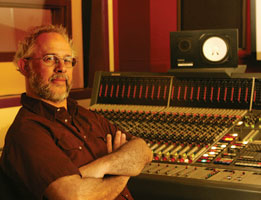|
|
It Was 20 Years Ago Today |
January 2006 |
|
This issue marks the start of EM's 21st year as a monthly publication. But this is the first issue in volume 22, not volume 21. Why is that? To begin with, EM's exact age depends on how you figure it. In 1975, a small group of electronic musicians led by editor Marvin Jones, his friends John and Linda Simonton, and several authors (most notably Craig Anderton), founded a tabloid-format magazine called Polyphony. The magazine's original tagline read ĺ─˙Electronic Music & Home Recording,ĺ─¨ and it featured interviews and how-to articles about synthesis, recording, computers, and electronics.
Although a few musicians experimented with computers in the late 1970s, that wasn't practical for most of us. Recording was about tape recorders, mixing consoles, and outboard gear, and pro-quality audio gear cost a fortune. Therefore, we used whatever we could get our hands on, and many of us built our own gear. John and Linda Simonton owned PAiA Electronics, a supplier of electronics kits for do-it-yourselfers (including the seminal Gnome synthesizer), and they initially published Polyphony to encourage people to experiment. Polyphony was not really a periodical, though; it was published, whenever its creators had enough material and time. (At press time, we learned that John Simonton has passed away after a bout with cancer. Please see his obituary at www.emusician.com.)
Eventually Jones moved on, and Anderton took over Polyphony's editorial reins. The magazine grew, but the home-recording/electronic-music world grew faster, and the ĺ─˙unperiodicalĺ─¨ tabloid couldn't keep up. So Polyphony was redesigned and upgraded, and in 1985, it reemerged as Electronic Musician, a modern-looking (for its day) and better organized magazine. Anderton and the Simontons published one issue of EM in June and another in September 1985, and that was volume 1. The magazine was in transition, however, and its future was uncertain. That all changed when Mix Publications, which published Mix magazine and distributed recording-oriented books, purchased EM and provided it with a professional staff and publishing expertise. Craig Anderton stayed on as our editor, and in January 1986, EM began monthly publication, marking the beginning of EM's ĺ─˙modern era.ĺ─¨ Because of the June and September 1985 issues, the January 1986 issue was volume 2, number 1. Hence, our 21st year begins with volume 22, number 1.
Since then, EM has gone through many changes. I started working on EM in late 1987 while copy editing for Mix. I went full time with EM early in 1988, and I'm the only EM staff member from that era who is still with the magazine. Anderton left in 1989, and Bob O'Donnell served as the editor until late 1993, when Mike Molenda took the hot seat. With Mike's late-1997 departure to take over Guitar Player magazine, I became EM's editor.
Many aspects of music technology have changed in 20 years, and we have striven to keep up and, when possible, to offer you a glimpse into the future. But with all those changes, EM's fundamental focus is the same as when it evolved from Polyphony 20 years ago ĺ─ţ and the same as Polyphony's original focus 30 years ago. EM is the home of creative electronic musicians who record in personal studios, and it always will be. ull time with EM early in 1988, and I'm the only EM staff member from that era who is still with the magazine. Anderton left in 1989, and Bob O'Donnell served as the editor until late 1993, when Mike Molenda took the hot seat. With Mike's late-1997 departure to take over Guitar Player magazine, I became EM's editor.
Many aspects of music technology have changed in 20 years, and we have striven to keep up and, when possible, to offer you a glimpse into the future. But with all those changes, EM's fundamental focus is the same as when it evolved from Polyphony 20 years ago ĺ─ţ and the same as Polyphony's original focus 30 years ago. EM is the home of creative electronic musicians who record in personal studios, and it always will be. |
